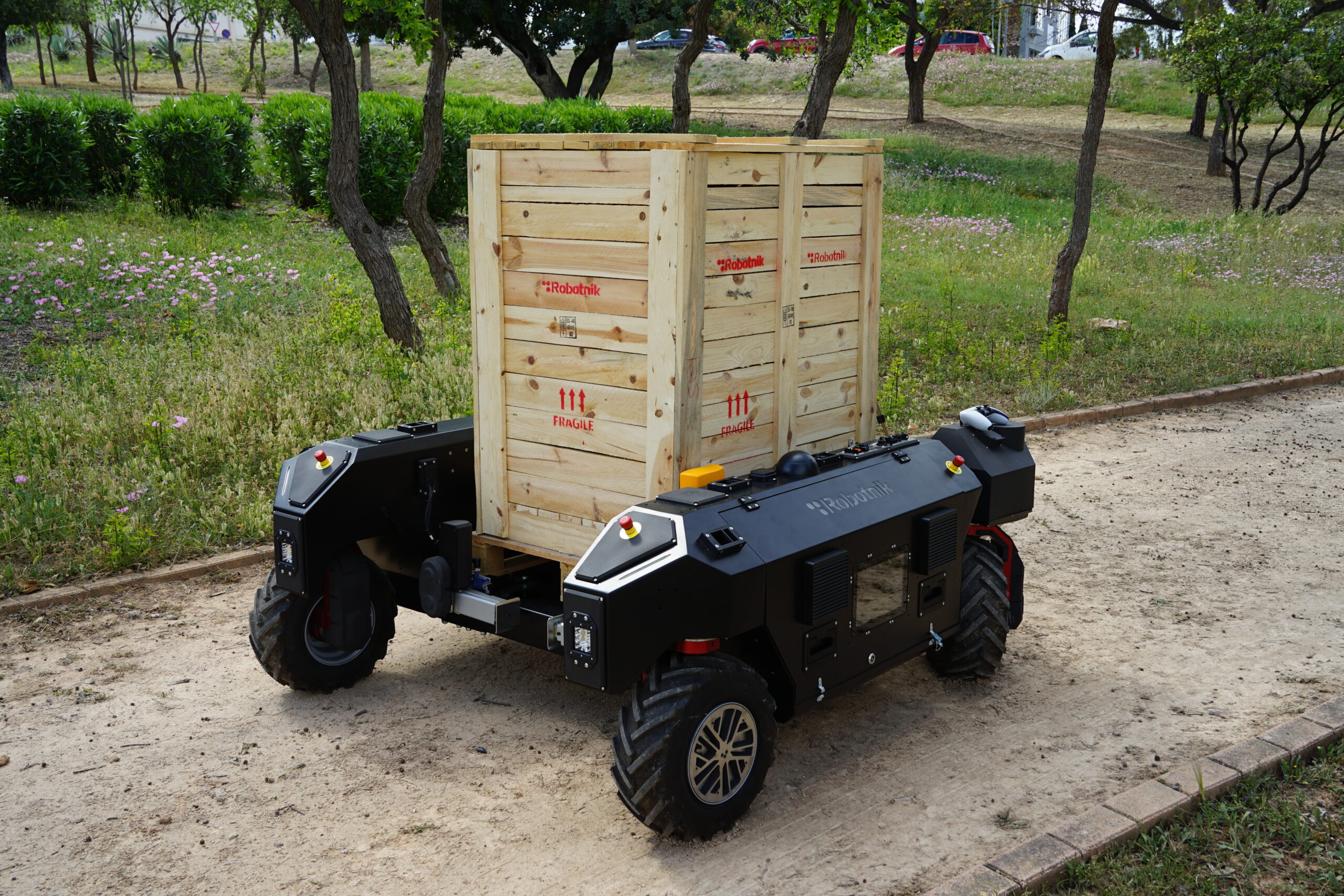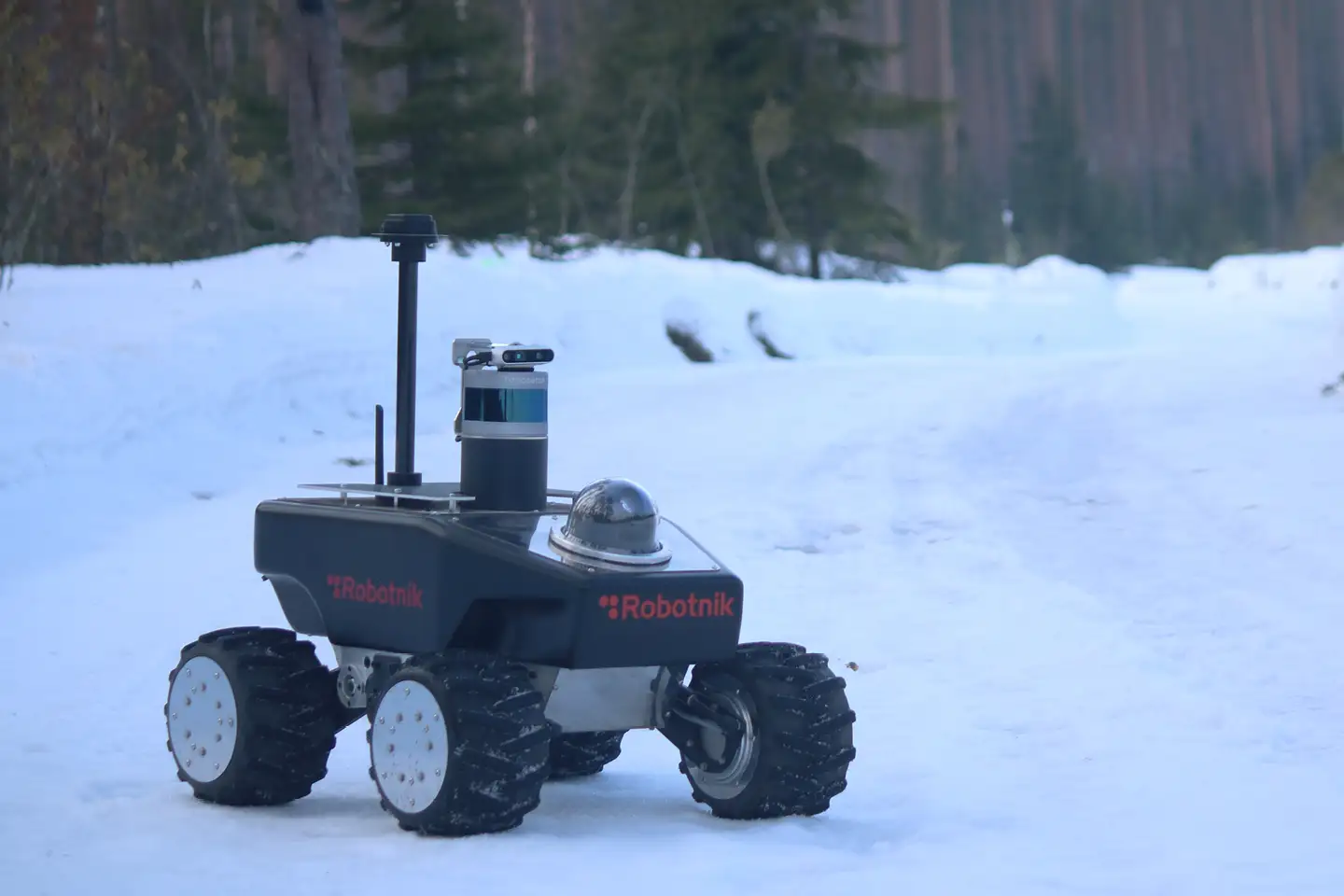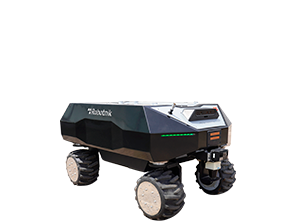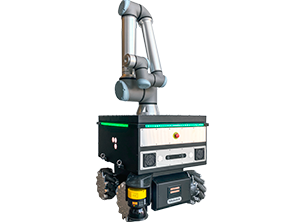In the previous article on autonomous mobile robotics for outdoor environments, various relevant aspects of this technology were explained in detail, both from a technical perspective and through real-world examples.
Below, Robotnik answers the 10 most frequently asked questions about outdoor mobile robots and their applications across various industries.
Unlike indoor autonomous vehicles, which are widely used in collaborative environments like warehouses and factories, outdoor autonomous systems are perhaps less well known. At Robotnik, with more than 20 years of experience in the development of outdoor robots, we aim to raise awareness and promote the potential these robots offer in sectors such as industry, construction, defense, agriculture, and logistics operations
1. What is an outdoor mobile robot?
It is a robotic system capable of navigating autonomously in open environments, avoiding obstacles, determining its position, and performing specific tasks without direct human intervention, thanks to the integration of advanced navigation and localization technologies.
Examples of outdoor mobile robots include Unmanned Ground Vehicles (UGVs), quadruped robots, and certain humanoid robots.
2. In which industries are outdoor autonomous mobile robots most used?
In recent years, the use of outdoor AMRs in R&D has significantly increased, especially for developing applications such as intelligent person-following, last-mile delivery, and navigation.
At an industrial level, the most common sectors using our outdoor robots are construction, agriculture, inspection, surveillance, and defense.
3. What is the cost of implementing an autonomous ground vehicle for outdoor use?
At Robotnik, we offer modular solutions that allow for customization of both hardware and software according to the needs of each application. Therefore, the final cost of the robot partly depends on project requirements.
As a general estimate, prices for outdoor AMRs on the market range between 25-55k, although less robust models for basic research projects can be found at lower prices.

4. What is the average speed of outdoor autonomous mobile robots?
The average speed of outdoor AMRs varies depending on terrain type, payload, and specific mission, but typically ranges between 1 and 3 meters per second.
All-terrain robots, due to rough surfaces, generally operate at lower speeds to ensure stability and safety, whereas robots navigating more controlled environments may reach higher speeds.
5. What are the main components of an outdoor mobile robot?
Outdoor AMRs consist of a combination of robust hardware and advanced software. Key components include a durable chassis to withstand harsh environmental conditions, actuators (electric or hydraulic motors) to drive movement, and wheels, tracks, or articulated legs depending on the system.
They also feature sensors such as LiDAR, RTK GPS, cameras, and IMUs for navigation and perception, along with high-capacity batteries, communication modules (WiFi, 4G/5G, radio), and processing units to run algorithms for localization, mapping, and path planning.
6. What sensors are commonly used in outdoor robotic platforms?
Outdoor robotic platforms incorporate a wide range of advanced sensors to allow autonomous mobile robots to perceive and understand their surroundings in real time.
Depending on the specific application, different sensors are needed — for example, thermographic sensors for inspecting critical infrastructure.
Commonly used sensors include LiDAR (for 3D mapping and obstacle detection), RTK GPS (for centimeter-level precise localization), RGB and infrared cameras (for visual recognition and low-light operation), IMUs (to estimate orientation and motion), and ultrasonic or radar sensors (for close-range object detection).
7. What types of traction do outdoor mobile robots use?
Outdoor mobile robots typically use three main traction systems depending on terrain and task:
- Wheels: Most common and efficient for off-road kinematics. Provide high maneuverability and stability on uneven terrain (like dirt, gravel, or grass), allowing smooth and energy-efficient travel without paved surfaces. They also consume less power and are faster over long distances than tracked systems.
- Tracks: Offer excellent traction on very uneven, soft, or muddy terrain by better distributing the robot’s weight. Provide strong climbing capabilities and obstacle handling, ideal for conditions where wheels might lose grip.
- Articulated or legged systems: Found in quadruped or humanoid robots, which are less widespread industrially but advantageous for specific tasks. This type of locomotion allows for climbing stairs or walking over rubble. The ability to adjust each limb ensures balance on slopes or unstable surfaces.
8. Is human supervision still required for outdoor autonomous mobile robots?
In most cases, outdoor AMRs still require some level of human supervision, mainly for safety and regulatory compliance.
Even though these robots are equipped with advanced sensors and intelligent systems to operate autonomously, remote supervision is essential for responding to unforeseen events, technical failures, or emergencies.
Many current regulations for autonomous vehicles (such as UGVs) require an operator to monitor and intervene if necessary. While the trend is toward increasing autonomy, human oversight remains critical to ensure safety and reliability.
9. Can outdoor autonomous mobile robots operate in rain or snow?
Robotnik’s outdoor AMRs are specifically designed to work in adverse weather conditions including rain, snow, and dust.
They feature rugged enclosures and appropriate IP-rated protection to ensure water and dust resistance.
Their navigation systems and sensors are calibrated to function reliably even in humid or low-visibility environments. For extreme climates, it’s recommended to consult our expert team to assess the appropriate configuration.

10. How long can an outdoor mobile robot operate on a single charge?
Los robots móviles autónomos de exterior de Robotnik están diseñados para funcionar en condiciones climáticas adversas, incluyendo lluvia, nieve y polvo. Cuentan con carcasas resistentes y certificaciones de protección IP adecuadas que garantizan la impermeabilidad y resistencia al polvo. Además, sus sensores y sistemas de navegación están calibrados para operar eficazmente en ambientes húmedos o con baja visibilidad, asegurando un desempeño confiable en exteriores, independientemente del clima. Para condiciones climáticas extremas, es mejor consultar con el equipo de expertos.
Battery life for outdoor AMRs varies significantly depending on payload, task type, and terrain.
Robotnik’s outdoor platforms typically operate for 5 to 10 hours on a single charge.
For demanding missions involving rough terrain or heavy loads, models are available with fast-charging capabilities or swappable battery systems to maximize uptime in the field.
RB-FIQUS,RB-VOGUI, RB-SUMMIT, and RB-WATCHERare the outdoor robotic platforms currently available in Robotnik’s portfolio — all of them modular and configurable to suit multiple applications and sectors.
For more information or to explore how to integrate these solutions into your company, contact us.
Preguntas frecuentes sobre la robots para exteriores
La robótica móvil de exterior se refiere a robots autónomos diseñados para operar en entornos al aire libre como áreas agrícolas, zonas industriales o áreas de seguridad.
Deben enfrentarse a terrenos impredecibles, condiciones climáticas variables y ausencia de referencias fijas, por lo que requieren hardware más robusto y sistemas de sensorización avanzados.
Chasis robustos, baterías de alta capacidad, GPS con RTK, LIDAR, software basado en IA y middleware ROS 2 son componentes fundamentales.
Agricultura, logística, seguridad, construcción y monitoreo ambiental son sectores clave que utilizan robots de exterior.

